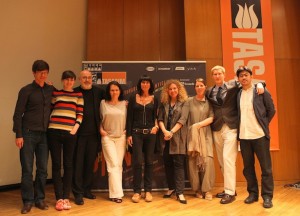The first edition of Istanbul Design Biennial, continued its evolving conversation with a roundtable discussion titled “Why Biennial?” on 26 May 2012.
Moderated by Ozlem Yalim Ozkaraoglu, Director of Istanbul Design Biennial, the meeting featured eight directors of biennials and triennials of worldwide repute. The attending speakers gave comprehensive presentations of their respective organisations and went on to discuss the objectives and impacts of design events that are steadily increasing in number every passing year. The main debate focused on, how the biennials can be used as a tool for generating critical discussion on design issues, and how that discussion would relate to the everyday life of society, and politics of design?
In the morning session, Elsa Frances, as the first speaker, expressed that since 1998 the St Etienne Biennial explores a different social theme in each of its runs. Over 10 curators will be participating in the St Etienne Biennial titled “empathy”. The objective of the biennial is to strengthen the ties between people, design and regional development through design practices.
Giovanna Massoni talked about the Belgium’s Liège Design Biennial, organised since 2002. She said that when she was appointed, one of the first things they did was to reduce the large number of events which then allowed them to be able to focus on the problems of the small city of Liège. The objective of the biennial is to expand into the surrounding regions prioritizing issues such as social innovation and collective creations of society. From now on, the event will continue to be organised triennially. In 2012, the biennial will showcase exhibitions entitled “Memorabilia”, “Crafts and Industry”, and “Make It Shapes”, along with special projects for children, urban practices realized in collaboration with universities and creation of meeting points for the people of the city.
Beatrice Galilee, Director of the 2013 Lisbon Architecture Triennial, an event organised since 2007, presented comprehensive examples from the previous editions of the triennial and stated the objective of the event as conducting research in the area of architecture and especially promote Portuguese architects. In 2013, the areas of focus will be new concepts such as architecture and pedagogy, neuroscience, geopolitics, fiction, politics. Galilee also explained that they introduced a new funding initiative called “crisis buster” whereby they provide financial support ranging from 100 to 500 Euros to anyone who would like to produce creative work under this programme. The Triennial uses a historical building donated by the local administration as the centre of organisational activities and a place where people can meet, access and share information.
Brendan McGetrick became the co-curator of the Gwangju Design Biennial alongside Ai Weiwei, in 2011. He expressed that the events of 2011 were followed by 256.000 people. The biennial encompassed 159 exhibitions, welcomed participation of 44 countries and adopted 4 official languages. He stressed the fact that of the entire audience, 100.000 were students. McGetrick said “Curatorship is social service” and that museums are treasure houses and biennials are laboratories. He stated that biennials play a very influential role on many mechanisms that award “good design” in the world, and emphasized the significance of each biennial actually exploring areas and issues that are not exactly pretty.
The afternoon session started with Weiwen Huang, Director of the Shenzhen&Hong Kong Bi-City Urban/Architecture Biennial. He put forth “the necessity of bringing functionality back to unused buildings” as the purpose of the his biennial. As an outcome of the events attended by 250.000 people in 2011, an unused police station, industrial buildings, empty lands and parks were redesigned and opened for the use of city residents.
Guta Moura Goudes has been organising the Lisboa Design Biennial: Experimenta since 2009. He drew attention to the difficulties of organising such events as biennials, occasionally encountered financial problems and the importance of the sustained effort behind actualizing a continual event that also manages to regenerate itself. Guedes talked about the various positive outcomes of experimenta in fields ranging from industry to economy, education, tourism and social innovation and concluded by adding that the biennial exhibitions also travel extensively abroad.
The history of the Moscow Graphic Design Biennial, one of the most prestigious events in the world of graphic design, goes back to the “Golden Bee” events that were first started in 1992. Dr Serge Serov was able to penetrate the iron gates in the post-perestroika period and experience events in different countries. He then grew the desire to actualize similar events in his own country with the help of his students which led to the creation of the “Golden Bee”, an event that kept growing its reputation over the years. In time “Golden Bee” developed into a biennial setting its target firstly as professionals, then students and lastly the public. Celebrating its 10th anniversary in 2012, the biennial’s theme this year is “decalogue”.
Matevž Čelik, Director of the Bio-Biennial of Industrial Design of Ljubljana, running into its 23rd year, talked about the systematic organisation of the events, the proportion of participating countries, and introduced the curators of this year’s event. He emphasized the biennial’s active role in the development of the city and introduction of new opportunities for young designers. He also pointed out that biennials serve to promote the local qualities, production methods, materials and talents of their respective regions.
Özlem Yalım Özkaraoğlu, as the last speaker, shared information about the Istanbul Design Biennial, which will be held for the first time this year, and answered questions. There was also an opportunity for a q&a session with the audience which led to the discussion of such topics as the role of biennials in increasing design value, their contributions to the environment, social development, politics, economics and education.


